| Description of High School Electives |
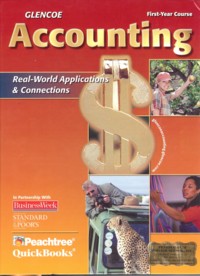 Accounting:
This is an advanced course consisting of 29 chapters divided into the following six units: (1) introduction to accounting, (2) the basic accounting cycle,
(3) accounting for a payroll system, (4) the accounting cycle for a merchandising corporation, (5) accounting for special procedures, and
(6) additional accounting topics. Chapter problems allow the student to apply what they have learned by performing actual accounting functions.
Real-world applications and connections apply and extend the chapter concepts to enrich the student's accounting knowledge. Accounting:
This is an advanced course consisting of 29 chapters divided into the following six units: (1) introduction to accounting, (2) the basic accounting cycle,
(3) accounting for a payroll system, (4) the accounting cycle for a merchandising corporation, (5) accounting for special procedures, and
(6) additional accounting topics. Chapter problems allow the student to apply what they have learned by performing actual accounting functions.
Real-world applications and connections apply and extend the chapter concepts to enrich the student's accounting knowledge. | 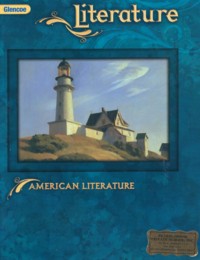 American Literature:
A collection of stories, poems, nonfiction articles and other literary works that is organized chronologically into seven units
spanning early America to the present. Background information is provided to help make the student's reading experience
more meaningful. A timeline helps keep track of major literary and historical events. A section titled Historical, Cultural, and
Social Forces explains the influence that shapes a specific literary period. American Literature:
A collection of stories, poems, nonfiction articles and other literary works that is organized chronologically into seven units
spanning early America to the present. Background information is provided to help make the student's reading experience
more meaningful. A timeline helps keep track of major literary and historical events. A section titled Historical, Cultural, and
Social Forces explains the influence that shapes a specific literary period. |
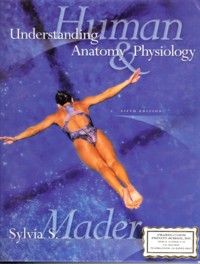 Anatomy & Physiology:
Helps advanced students to develop a working knowledge of (1) human anatomy and physiology that is based on conceptual understanding
rather than rote memory; (2) medical technology that will increase the student's confidence in their chosen field; and (3) clinical
applications to broaden their horizons beyond the core principles. Anatomy & Physiology:
Helps advanced students to develop a working knowledge of (1) human anatomy and physiology that is based on conceptual understanding
rather than rote memory; (2) medical technology that will increase the student's confidence in their chosen field; and (3) clinical
applications to broaden their horizons beyond the core principles. |
 Animal Husbandry:
Provides a condensed, highly illustrated, easy-to-read version of the
wonders, as well as the technical aspects, of animal science. Text
includes chapters on beef cattle, diseases, dairy industry, sheep,
goats, swine, poultry, horses, and rabbits. Animal Husbandry:
Provides a condensed, highly illustrated, easy-to-read version of the
wonders, as well as the technical aspects, of animal science. Text
includes chapters on beef cattle, diseases, dairy industry, sheep,
goats, swine, poultry, horses, and rabbits. |
 Drive Right:
This course provides basic instruction in vehicle operation, maneuvers, and more. The taking of this course in no way
guarantees the student will receive a driver's permit or license. Please check your local state requirements. Drive Right:
This course provides basic instruction in vehicle operation, maneuvers, and more. The taking of this course in no way
guarantees the student will receive a driver's permit or license. Please check your local state requirements. |
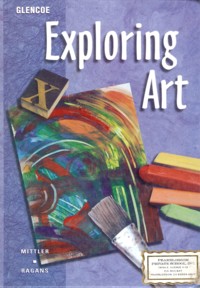 Art, Exploring:
Takes a media approach to art, focusing on the elements and principles of art
and how artists use various media and techniques, such as drawing,
painting, printmaking, and sculpting. The concepts of aesthetics, art
criticism, art history, and art production are applied and reinforced. This satisfies the 1 Credit required in Visual/Lang./Performing Arts. Art, Exploring:
Takes a media approach to art, focusing on the elements and principles of art
and how artists use various media and techniques, such as drawing,
painting, printmaking, and sculpting. The concepts of aesthetics, art
criticism, art history, and art production are applied and reinforced. This satisfies the 1 Credit required in Visual/Lang./Performing Arts. |
 Art, Understanding:
Takes a chronological approach to art, focusing on art works from
ancient to contemporary times. The text blends art history with
cultural and social traditions, emphasizing the role of art in everyday
life. The images and content present art as historical evidence of the
creative process. This satisfies the 1 Credit required in Visual/Lang./Performing Arts. Art, Understanding:
Takes a chronological approach to art, focusing on art works from
ancient to contemporary times. The text blends art history with
cultural and social traditions, emphasizing the role of art in everyday
life. The images and content present art as historical evidence of the
creative process. This satisfies the 1 Credit required in Visual/Lang./Performing Arts. |
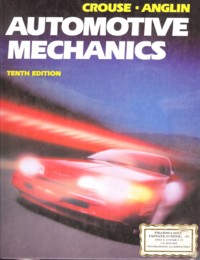 Automotive Mechanics:
This course is correlated with federal, state, apprenticeship, and
industry guidelines for automotive technician training. The text along
with the consumable student workbook can be used for reference, study,
and test preparation by anyone preparing for automotive technician
certification programs. Automotive Mechanics:
This course is correlated with federal, state, apprenticeship, and
industry guidelines for automotive technician training. The text along
with the consumable student workbook can be used for reference, study,
and test preparation by anyone preparing for automotive technician
certification programs. |
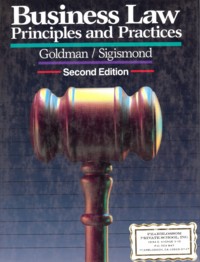 Business Law:
Provides activities to let students monitor their progress while new
unit end case activities prompt them to analyze the issues and "be the
judge." Numerous examples and case anecdotes clarify concepts and
enable students to "apply" the law to real life situations. All the
important legal topics are covered. Business Law:
Provides activities to let students monitor their progress while new
unit end case activities prompt them to analyze the issues and "be the
judge." Numerous examples and case anecdotes clarify concepts and
enable students to "apply" the law to real life situations. All the
important legal topics are covered. |
 Computer Literacy:
This course teaches the student how to program the computer using the BASIC computer language.
The student will learn how to actually write computer code or statements to solve problems and
then print or display the answers. This presents the fundamentals of programming and following this course,
the student will be able to grasp other programming languages (such as C, C+, Pascal, HTML, and others) more easily. Computer Literacy:
This course teaches the student how to program the computer using the BASIC computer language.
The student will learn how to actually write computer code or statements to solve problems and
then print or display the answers. This presents the fundamentals of programming and following this course,
the student will be able to grasp other programming languages (such as C, C+, Pascal, HTML, and others) more easily. |
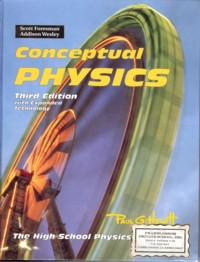 Conceptual Physics: Physics
is treated conceptually in this course, which means concepts are
presented in familiar English, with equations as "guides to thinking."
Comprehension of concepts before calculation is the key to
understanding. Conceptual Physics: Physics
is treated conceptually in this course, which means concepts are
presented in familiar English, with equations as "guides to thinking."
Comprehension of concepts before calculation is the key to
understanding. |
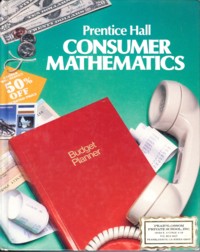 Consumer Mathematics:
Develops mastery of skills and applies them to real life. Basic skills
and problem solving are covered in the first two units; practical
applications are covered in the remaining five units. Consumer Mathematics:
Develops mastery of skills and applies them to real life. Basic skills
and problem solving are covered in the first two units; practical
applications are covered in the remaining five units. |
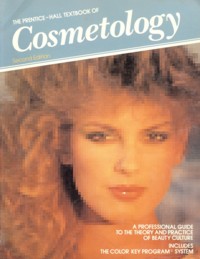 Cosmetology:
This course is available for up to 40 elective credits (10 each
course). The introductory course covers topics such as looks, skin,
hair, nails, anatomy and physiology, bacteriology and sanitation. The
intermediate course covers shampoos and rinses, scalp treatments and
hair conditioners, basic hair shaping, precision hair cutting, wet and
thermal hair styling. Cosmetology:
This course is available for up to 40 elective credits (10 each
course). The introductory course covers topics such as looks, skin,
hair, nails, anatomy and physiology, bacteriology and sanitation. The
intermediate course covers shampoos and rinses, scalp treatments and
hair conditioners, basic hair shaping, precision hair cutting, wet and
thermal hair styling. |
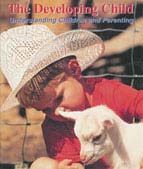 Developing Child:
This course covers observing children, baby sitting, child care,
preschools, exceptional children, teen pregnancy and parenthood, and
family stresses. Comprehensive and up to date coverage of physical,
mental, social, emotional, and moral development theories of child
development Piaget, Erikson, Kohlberg, parenthood, pregnancy and birth. Developing Child:
This course covers observing children, baby sitting, child care,
preschools, exceptional children, teen pregnancy and parenthood, and
family stresses. Comprehensive and up to date coverage of physical,
mental, social, emotional, and moral development theories of child
development Piaget, Erikson, Kohlberg, parenthood, pregnancy and birth. |
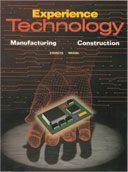 Experience Technology Manufacturing & Construction:
This book includes a science and math handbook, glossary of terms, and
chapters on topics such as Forming a Company, Researching and
Developing a Product, Materials, Controlling Manufacturing Quality,
Construction Processes, and many more. It comes with a consumable
student workbook that contains chapter reviews, basic skills
activities, and technology activities. Experience Technology Manufacturing & Construction:
This book includes a science and math handbook, glossary of terms, and
chapters on topics such as Forming a Company, Researching and
Developing a Product, Materials, Controlling Manufacturing Quality,
Construction Processes, and many more. It comes with a consumable
student workbook that contains chapter reviews, basic skills
activities, and technology activities. |
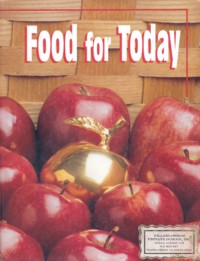 Food for Today:
This course is a well-balanced introduction to foods and nutrition that
gives students the background knowledge and skills in 25 chapters that are in five basic units: (1)
food, nutrition, and you, (2) workspace, tools, and techniques, (3) consumer decisions, (4) foods for meals and snacks, and (5) expanding your horizons (careers in food). Food for Today:
This course is a well-balanced introduction to foods and nutrition that
gives students the background knowledge and skills in 25 chapters that are in five basic units: (1)
food, nutrition, and you, (2) workspace, tools, and techniques, (3) consumer decisions, (4) foods for meals and snacks, and (5) expanding your horizons (careers in food). |
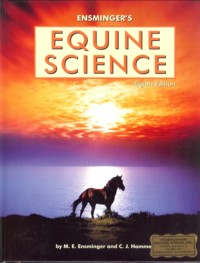 Equine Science:
This new edition is organized into 14 sections and 59 topics that
address the history of the horse, common breeds of horses, donkeys, and
mules, confirmation principles, horse genetics, anatomy, physiology,
and management aspects of equine reproduction and nutrition, horse
behavior and training, tack and equipment, employment opportunities in
the equine industry, and more. Equine Science:
This new edition is organized into 14 sections and 59 topics that
address the history of the horse, common breeds of horses, donkeys, and
mules, confirmation principles, horse genetics, anatomy, physiology,
and management aspects of equine reproduction and nutrition, horse
behavior and training, tack and equipment, employment opportunities in
the equine industry, and more. |
 Food Science & Safety:
Explains how to achieve career success in the food industry. The
chapters explain the role and potential that food science has in the
food industry. This introductory book helps the student explore the
relationship of Food Science to disciplines such as marketing, product
development, and international development. Food Science & Safety:
Explains how to achieve career success in the food industry. The
chapters explain the role and potential that food science has in the
food industry. This introductory book helps the student explore the
relationship of Food Science to disciplines such as marketing, product
development, and international development. |
 Forensic Science:
This is an advanced elelective. Each chapter begins with a gripping forensic case showing students how
each chapter relates to the real world. Full-color illustrations help
students to better understand key forensic concepts. Forensic-specific
vocabulary is explained in the text margin. Forensic Science:
This is an advanced elelective. Each chapter begins with a gripping forensic case showing students how
each chapter relates to the real world. Full-color illustrations help
students to better understand key forensic concepts. Forensic-specific
vocabulary is explained in the text margin. |
 Journalism Matters:
This course brings the student up to speed as a working journalist. The chapters train the student to write well--summarize information, describe observations
and accurately record the views and comments of others. Other chapters also cover interviewing, sports writing, feature writing, and the special demands of column
and review writing. Still other chapters cover the knowledge and skills required to bring a product to the public's attention. This satisfies the 1 Credit required in Visual/Lang./Performing Arts. Journalism Matters:
This course brings the student up to speed as a working journalist. The chapters train the student to write well--summarize information, describe observations
and accurately record the views and comments of others. Other chapters also cover interviewing, sports writing, feature writing, and the special demands of column
and review writing. Still other chapters cover the knowledge and skills required to bring a product to the public's attention. This satisfies the 1 Credit required in Visual/Lang./Performing Arts. |
 Livestock:
This course serves as an introduction to animal science and veterinary
technology. It is about far more than cattle, swine, and chickens,
though these are included. Basics of biology and veterinary technology
practices are included. The course covers aquatic animals, draft
animals, dogs, cats, birds, rodents, reptiles and service, laboratory,
and exotic animals. Livestock:
This course serves as an introduction to animal science and veterinary
technology. It is about far more than cattle, swine, and chickens,
though these are included. Basics of biology and veterinary technology
practices are included. The course covers aquatic animals, draft
animals, dogs, cats, birds, rodents, reptiles and service, laboratory,
and exotic animals. |
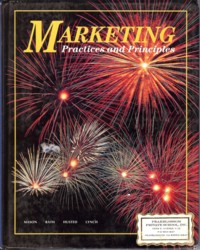 Marketing Practices and Principles:
Contains 42 chapters dealing with the world of marketing, the consumer
market, special markets, marketing research, the product, pricing,
channels of distribution, wholesaling, advertising, marketing
management, business management, and entrepreneurship. Marketing Practices and Principles:
Contains 42 chapters dealing with the world of marketing, the consumer
market, special markets, marketing research, the product, pricing,
channels of distribution, wholesaling, advertising, marketing
management, business management, and entrepreneurship. |
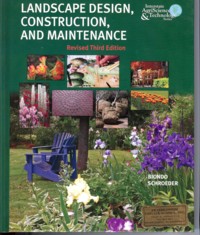 Landscape Design, Construction, and Maintenance:
Introduces various aspects of the landscape industry. Plant selection
and care at the foundation of the book. Landscaping has been one of the
fastest growing segments of the horticulture industry. The design of
new landscapes, the building of landscapes, and the maintenance of
existing landscapes are in high demand. The steps to developing a
complete and functional landscape plan for the residential setting are
identified and explained. Landscape Design, Construction, and Maintenance:
Introduces various aspects of the landscape industry. Plant selection
and care at the foundation of the book. Landscaping has been one of the
fastest growing segments of the horticulture industry. The design of
new landscapes, the building of landscapes, and the maintenance of
existing landscapes are in high demand. The steps to developing a
complete and functional landscape plan for the residential setting are
identified and explained. |
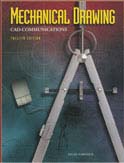 Mechanical Drawing (CAD-Communications):
Introduces students to CAD (Computer Aided Drafting). The student
learns to visualize in three dimension, to build technical
imaginations, to think precisely, and to understand the language and
gain the skills required by today's industry. The course heavily
emphasis the basic elements and concepts of drafting. A student
workbook is provided which includes drawing assignments that thoroughly
cover all basic elements of drafting. A variety of advanced problems
are also included to accommodate the student who has progressed at a
quicker rate. Mechanical Drawing (CAD-Communications):
Introduces students to CAD (Computer Aided Drafting). The student
learns to visualize in three dimension, to build technical
imaginations, to think precisely, and to understand the language and
gain the skills required by today's industry. The course heavily
emphasis the basic elements and concepts of drafting. A student
workbook is provided which includes drawing assignments that thoroughly
cover all basic elements of drafting. A variety of advanced problems
are also included to accommodate the student who has progressed at a
quicker rate. |
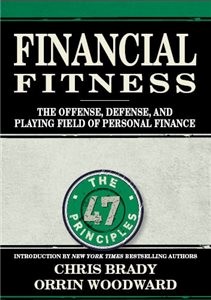 Personal Finance:
The Financial Fitness course is for everyone. Just as one becomes physically
or mentally fit, one becomes financially fit through the same two requirements:
knowing what to do and taking the necessary action to do it. Regardless of your
current financial situation, you can learn to prosper, conserve, and multiply
the fruits of your labor through a basic understanding of the principles behind
the Offense, Defense, and Playing Field of personal finance. This course brings all of these fundamentals together in one convenient
location so you can become the master of your money and prosper in any economy. Personal Finance:
The Financial Fitness course is for everyone. Just as one becomes physically
or mentally fit, one becomes financially fit through the same two requirements:
knowing what to do and taking the necessary action to do it. Regardless of your
current financial situation, you can learn to prosper, conserve, and multiply
the fruits of your labor through a basic understanding of the principles behind
the Offense, Defense, and Playing Field of personal finance. This course brings all of these fundamentals together in one convenient
location so you can become the master of your money and prosper in any economy. |
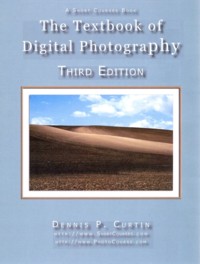 Digital Photography:
This e-book (or electronic book supplied as a DVD) focuses on core material--those aspects of photography that are essential to understand. Included are separate online animations,
movies, Web sites, Excel worksheets and PDFs designed to help you better understand the basic concepts of digital photography so that it
is easier for you to master your camera and its controls. Although having a digital camera will enhance your experience during this course, it is not mandatory that you have such a camera.
Digital Photography:
This e-book (or electronic book supplied as a DVD) focuses on core material--those aspects of photography that are essential to understand. Included are separate online animations,
movies, Web sites, Excel worksheets and PDFs designed to help you better understand the basic concepts of digital photography so that it
is easier for you to master your camera and its controls. Although having a digital camera will enhance your experience during this course, it is not mandatory that you have such a camera. |
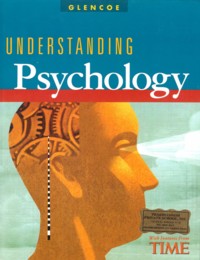 Understanding Psychology:
As a social science, psychology explores the influence of society on individual behavior and group relationships.
As a natural science, psychology looks for biological explanations for human behavior. The student will learn to think like a scientist and use
the scientific method to solve problems. The student will learn more about himself/herself and more about others.
Psychologists attempt to explain and predict why people behave, feel, and think as they do. They attempt to learn ways in which
people can improve the quality of life. Understanding Psychology:
As a social science, psychology explores the influence of society on individual behavior and group relationships.
As a natural science, psychology looks for biological explanations for human behavior. The student will learn to think like a scientist and use
the scientific method to solve problems. The student will learn more about himself/herself and more about others.
Psychologists attempt to explain and predict why people behave, feel, and think as they do. They attempt to learn ways in which
people can improve the quality of life. |
 Glencoe Speech:
The text covers a full range of topics, from different types of interpersonal communication to preparing and presenting speeches to debate and parliamentary procedure.
The tone of the text is friendly and engaging. The authors believe strongly that communication is a key skill for all people and have, therefore developed the exercises and
activities to address the various aspects of communication as well as how it relates to life at school, at work, and in relationships. The text includes many cartoons and
humorous anecdotes. The quips and quotes will entertain you. The writing style is personal and friendly. This satisfies the 1 Credit required in Visual/Lang./Performing Arts. Glencoe Speech:
The text covers a full range of topics, from different types of interpersonal communication to preparing and presenting speeches to debate and parliamentary procedure.
The tone of the text is friendly and engaging. The authors believe strongly that communication is a key skill for all people and have, therefore developed the exercises and
activities to address the various aspects of communication as well as how it relates to life at school, at work, and in relationships. The text includes many cartoons and
humorous anecdotes. The quips and quotes will entertain you. The writing style is personal and friendly. This satisfies the 1 Credit required in Visual/Lang./Performing Arts. |
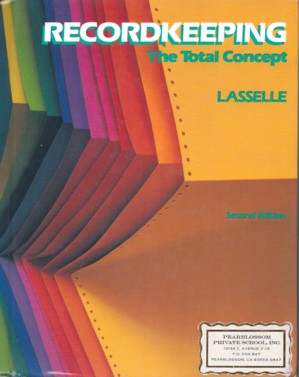 Recordkeeping:
Provides skills training in one of the most common entry level
accounting positions, plus skills development in reading and
comprehension, communications, human relations, organizations, and
other skills vital to job success. Recordkeeping:
Provides skills training in one of the most common entry level
accounting positions, plus skills development in reading and
comprehension, communications, human relations, organizations, and
other skills vital to job success. |
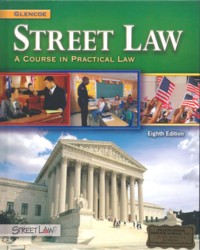 Street Law:
Presents topics dealing with the most current law-related issues, including terrorism, technology, and immigration law.
Emphasis is placed on promoting alternative (nonjudicial) forms of dispute resolution. This course provides practical
information and problem-solving opportunities that provide students with the knowledge and skills necessary for
survival in a law-saturated society. The curriculum includes case studies, mock trials, and role-plays. Street Law:
Presents topics dealing with the most current law-related issues, including terrorism, technology, and immigration law.
Emphasis is placed on promoting alternative (nonjudicial) forms of dispute resolution. This course provides practical
information and problem-solving opportunities that provide students with the knowledge and skills necessary for
survival in a law-saturated society. The curriculum includes case studies, mock trials, and role-plays. |
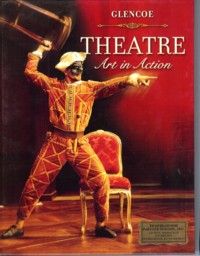 Glencoe Theatre:
Assists the student in learning about theatre by offering a variety of interesting and stimulating activities and performance projects. There are exercises in which the
student can immediately apply the skills that he/she are learning. Three major strands deal with Acting, Directing & Producing, and Technical Theatre. These strands
are organized into four sections: Exploration which explains the basic tools and techniques; Preparatory which gets the student ready for a production; Performance which
moves through the rehearsal process to opening night; and Specialization which presents various types of specialized theatre activities. This satisfies the 1 Credit required in Visual/Lang./Performing Arts. Glencoe Theatre:
Assists the student in learning about theatre by offering a variety of interesting and stimulating activities and performance projects. There are exercises in which the
student can immediately apply the skills that he/she are learning. Three major strands deal with Acting, Directing & Producing, and Technical Theatre. These strands
are organized into four sections: Exploration which explains the basic tools and techniques; Preparatory which gets the student ready for a production; Performance which
moves through the rehearsal process to opening night; and Specialization which presents various types of specialized theatre activities. This satisfies the 1 Credit required in Visual/Lang./Performing Arts. |
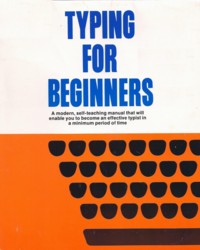 Typing:
This course is supplied in text book form or the student may utilize
any computer typing tutor program of their choice (usually available at
any software retail store). Typing:
This course is supplied in text book form or the student may utilize
any computer typing tutor program of their choice (usually available at
any software retail store). |
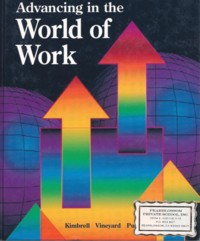 World of Work, Advancing in the:
Shows how to meet challenges with confidence and provides knowledge
needed to advance in your career. Explore skills such as communication,
math, and computer skills. World of Work, Advancing in the:
Shows how to meet challenges with confidence and provides knowledge
needed to advance in your career. Explore skills such as communication,
math, and computer skills. |
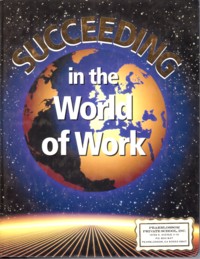 World of Work, Succeeding in the:
An easy-to-read and easy-to-comprehend text divided into seven units which lead students from Self Assessment,
Exploring Careers, and Finding a Job through Joining the Workforce and Professional Development, and on to Lifelong Learning.
Special features in each chapter are designed to engage students
interest, for example Exploring Career Do's and Don'ts and others. World of Work, Succeeding in the:
An easy-to-read and easy-to-comprehend text divided into seven units which lead students from Self Assessment,
Exploring Careers, and Finding a Job through Joining the Workforce and Professional Development, and on to Lifelong Learning.
Special features in each chapter are designed to engage students
interest, for example Exploring Career Do's and Don'ts and others. |
Additional High School Electives |
 Beginning Speech:
This satisfies the 1 Credit required in Visual/Lang./Performing Arts. One semester (1/2 year) of Speech credit is issued for each
80 hours of field service activity. A maximum of 480 hours can
provide credit in three different courses: Beginning Speech (160
hours), Advanced Speech (160 hours), and Career Planning (160
hours). Only those who are aux. or reg. pioneers can receive credit for Career Planning. Beginning Speech:
This satisfies the 1 Credit required in Visual/Lang./Performing Arts. One semester (1/2 year) of Speech credit is issued for each
80 hours of field service activity. A maximum of 480 hours can
provide credit in three different courses: Beginning Speech (160
hours), Advanced Speech (160 hours), and Career Planning (160
hours). Only those who are aux. or reg. pioneers can receive credit for Career Planning. |
 Work experience:
Work experience credit for documented employment. In
California, we are authorized to issue work permits to students
that pursue employment. The employer (and not the school) is
responsible for obtaining the required insurance and liability
coverage. If located outside California, check with your local school district office regarding
issuance of a work permit. Work experience:
Work experience credit for documented employment. In
California, we are authorized to issue work permits to students
that pursue employment. The employer (and not the school) is
responsible for obtaining the required insurance and liability
coverage. If located outside California, check with your local school district office regarding
issuance of a work permit. |
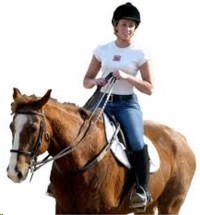 Horsemanship:
Horsemanship as a career is available to those
distant students involved in Parelli equestrian training as well as local
students using the full service on site equestrian facility which
includes a lighted arena. Credit for Horsemanship is granted upon
completion of any Parelli Savvy Level (1 through 4) and
submission of a copy of an Official Level Certificate to
Pearblossom Private School, Inc. Horsemanship:
Horsemanship as a career is available to those
distant students involved in Parelli equestrian training as well as local
students using the full service on site equestrian facility which
includes a lighted arena. Credit for Horsemanship is granted upon
completion of any Parelli Savvy Level (1 through 4) and
submission of a copy of an Official Level Certificate to
Pearblossom Private School, Inc. |
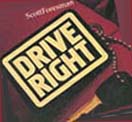 Driver's Education:
The textbook
portion of Driver's Education is recognized by many states (not Texas) and
allows the student to be issued a temporary driver's permit upon
passing the state exam. Check with your local Department of Motor Vehicles or Highway Patrol
for requirements in your area. Driver's Education:
The textbook
portion of Driver's Education is recognized by many states (not Texas) and
allows the student to be issued a temporary driver's permit upon
passing the state exam. Check with your local Department of Motor Vehicles or Highway Patrol
for requirements in your area. |
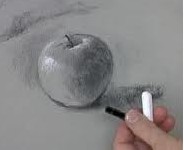 Draw Today/Paint Today:
This satisfies the 1 Credit required in Visual/Lang./Performing Arts. Draw Today (using charcoal) and Paint Today (which includes acrylic paint) courses include all necessary art
supplies for a hands-on elective that contains drawing materials
and an instructional DVD. Please note the additional fee of $75 for Draw Today and $100 for Paint today. Draw Today/Paint Today:
This satisfies the 1 Credit required in Visual/Lang./Performing Arts. Draw Today (using charcoal) and Paint Today (which includes acrylic paint) courses include all necessary art
supplies for a hands-on elective that contains drawing materials
and an instructional DVD. Please note the additional fee of $75 for Draw Today and $100 for Paint today. |
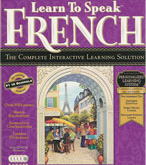 Foreign Language:
Foreign Language CD's assist the learning of
Chinese, French, Italian, German, and Japanese. These CD's actually play
computer video's of people speaking the language. Spanish is now provided in a comprehensive online course that includes an online reference book.
Please specify the desired language on the application and note the additional fee of $75. This satisfies the 1 Credit required in Visual/Lang./Performing Arts. (Note: All languages require a headphone/microphone headset that is not included and must be purchased separately.)
Call for availability of other languages. Foreign Language:
Foreign Language CD's assist the learning of
Chinese, French, Italian, German, and Japanese. These CD's actually play
computer video's of people speaking the language. Spanish is now provided in a comprehensive online course that includes an online reference book.
Please specify the desired language on the application and note the additional fee of $75. This satisfies the 1 Credit required in Visual/Lang./Performing Arts. (Note: All languages require a headphone/microphone headset that is not included and must be purchased separately.)
Call for availability of other languages. |
| Top |